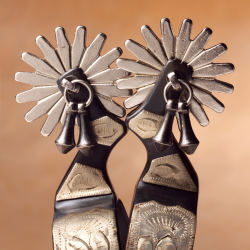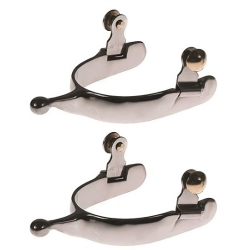Tripping Collar: Features and Benefits
When it comes to selecting the right tack for your horse, understanding the features and benefits of different options is essential. In this section, we will delve into the world of tripping collars and explore their unique features and advantages.
A tripping collar is specifically designed for use in Western riding disciplines. It serves a crucial purpose by preventing the saddle from sliding forward during sudden stops, turns, or movements that may occur while working cattle or participating in rodeo events. The tripping collar is typically made of durable leather or synthetic materials and is positioned around the horse's neck, just behind the horse's shoulders.
One of the key features of a tripping collar is its wide and contoured shape. It is wider in the front and tapers towards the back, ensuring a snug and secure fit around the horse's neck. This design helps distribute the pressure evenly, reducing the risk of discomfort or chafing. The tripping collar also features a central ring or D-ring at the front, which serves as an attachment point for the breast collar tug straps, providing additional stability and preventing the saddle from shifting forward.
The primary benefit of using a tripping collar is enhanced stability and balance. When a horse performs sudden stops or turns, the forward momentum can cause the saddle to shift forward, potentially compromising the rider's position and the horse's comfort. The tripping collar acts as a reliable anchor, keeping the saddle in place and maintaining balance.
Another advantage of the tripping collar is its ability to prevent the forward movement of the saddle. This is particularly crucial when working with cattle or engaging in activities that require quick and agile maneuvers. By securing the saddle in place, the tripping collar allows the rider to maintain control and stability, even in challenging situations.
The tripping collar also plays a role in improving control and maneuverability. It helps the rider communicate more effectively with the horse, providing clear and precise cues. With the saddle securely positioned, the rider can focus on maintaining a balanced seat and executing precise movements, allowing for better control and responsiveness from the horse.
In real-life scenarios, tripping collars have proven to be invaluable for riders participating in rodeo events, such as roping or barrel racing. These high-intensity activities require quick stops, turns, and changes of direction, making the stability and balance offered by a tripping collar crucial for both horse and rider.
In conclusion, the tripping collar is a specialized piece of tack designed for Western riders who engage in activities that require sudden stops, turns, and quick movements. Its wide and contoured shape, along with the attachment point for the breast collar tug straps, provides enhanced stability and prevents forward saddle movement. With improved stability, balance, and control, riders can confidently navigate challenging situations. In the next section, we will explore the features and benefits of another popular tack option: the breast collar.
Breast Collar: Features and Benefits
In this section, we will shift our focus to the breast collar, another popular tack option used in both Western and English riding disciplines. The breast collar serves a different purpose than the tripping collar, and understanding its features and benefits is essential for making an informed tack selection.
A breast collar is a piece of equipment that is positioned across the horse's chest and shoulders, attaching to the saddle on either side. It is typically made of leather or synthetic materials and comes in various styles and designs to accommodate different riding disciplines and personal preferences.
One of the key features of a breast collar is its ability to distribute weight and pressure evenly across the horse's chest and shoulders. This even distribution helps alleviate strain on the horse's back and prevents the saddle from slipping backward or sideways. By providing stability and support, the breast collar enhances the horse's comfort, allowing for a more enjoyable riding experience.
The breast collar also plays a crucial role in preventing saddle slippage. When riding on uneven terrain or engaging in activities that involve sudden movements, there is a risk of the saddle shifting out of place. The breast collar acts as an anchor, keeping the saddle securely positioned, even during challenging maneuvers. This ensures the rider's stability and maintains the horse's balance, reducing the risk of accidents or discomfort.
Support for forward movement is another advantage of using a breast collar. During activities that require the horse to extend its stride or push from the hindquarters, the breast collar helps distribute the force evenly, providing additional support to the horse's chest and shoulders. This support allows the horse to move more freely and efficiently, enhancing its performance and overall athletic ability.
It is important to note that the design of the breast collar can vary depending on the riding discipline. In Western riding, the breast collar may feature decorative details, such as tooling or silver accents, to complement the traditional Western tack aesthetic. In English riding, the breast collar is often more streamlined and minimalistic, focusing on functionality and simplicity.
Real-life examples showcase the effectiveness of the breast collar in various riding activities. In Western disciplines, such as ranch work or trail riding, the breast collar provides stability and support, ensuring the horse's comfort during long hours in the saddle. In English disciplines, such as eventing or jumping, the breast collar helps maintain the saddle's position during intense movements, allowing the rider to maintain balance and control.
In conclusion, the breast collar is a versatile piece of tack that offers several features and benefits. By distributing weight and pressure evenly, preventing saddle slippage, and providing support for forward movement, the breast collar enhances the horse's comfort and performance. Whether in Western or English riding disciplines, the breast collar plays a crucial role in ensuring a secure and enjoyable riding experience. In the next section, we will compare and contrast the tripping collar and breast collar, exploring the factors to consider when choosing between the two.
Comparing Tripping Collar and Breast Collar
In this section, we will delve into a comparative analysis of the tripping collar and breast collar, exploring the differences in design, suitability for various riding disciplines, and the factors to consider when choosing between the two.
Firstly, let's discuss the differences in design and construction between the tripping collar and breast collar. The tripping collar is specifically designed to prevent saddle movement forward, with its wide and contoured shape providing stability and balance. It is positioned around the horse's neck, just behind the shoulders, and features a central ring or D-ring for attaching the breast collar tug straps. On the other hand, the breast collar is positioned across the horse's chest and shoulders, attaching to the saddle on either side. It is wider in the front and narrower towards the back, ensuring even weight distribution and preventing saddle slippage.
The suitability of the tripping collar and breast collar can also vary depending on the riding discipline. In Western riding disciplines, such as ranch work, team penning, or barrel racing, the tripping collar is commonly used. Its design and functionality cater to the quick stops, turns, and maneuvers typically required in these activities. The tripping collar provides the necessary stability and balance, ensuring the saddle remains securely in place during intense movements.
In English riding disciplines, the breast collar is more commonly utilized. Activities such as jumping, eventing, or dressage require a different set of skills and movements compared to Western riding. The breast collar's ability to distribute weight evenly and prevent saddle slippage is crucial in maintaining the rider's balance and the horse's comfort during jumps or intricate maneuvers. The streamlined design of the breast collar also complements the aesthetic of English tack.
When choosing between the tripping collar and breast collar, several factors should be considered. Firstly, the horse's conformation and anatomy play a vital role. Each horse is unique, and their body shape and build can influence the effectiveness of the collar. For example, a horse with a well-defined wither might benefit more from a breast collar, as it can help prevent the saddle from sliding back on their back.
The rider's preferences and riding style should also be taken into account. Some riders may have a personal preference for a specific type of collar based on their experience or comfort. Additionally, riding style can influence the choice between a tripping collar and breast collar. Riders who primarily engage in Western disciplines may find the tripping collar more suitable, while riders in English disciplines may lean towards the breast collar.
Specific goals and activities also factor into the decision-making process. Riders who participate in rodeo events or engage in intense Western riding activities may benefit from the stability and control offered by the tripping collar. On the other hand, riders involved in English disciplines that focus on precision, elegance, and jumping may find the breast collar better suited to their needs.
In conclusion, the tripping collar and breast collar serve different purposes and are suited to specific riding disciplines. Understanding the differences in design, considering the horse's conformation and anatomy, and taking into account the rider's preferences and specific goals are essential when choosing between the two. Both collars provide unique features and benefits, enhancing the horse's comfort and the rider's control. Ultimately, selecting the appropriate collar depends on the individual horse, rider, and the activities they participate in. In the next section, we will present case studies that highlight the effectiveness of both collars in different scenarios.
Examples: Tripping Collar vs. Breast Collar in Different Scenarios
To provide a more comprehensive understanding of the effectiveness of tripping collars and breast collars, let's explore some real-life case studies that showcase how each collar performs in different riding scenarios.
Example 1: Rodeo Events
Tripping Collar In the world of rodeo events, such as roping or barrel racing, the tripping collar plays a vital role. Take, for example, a team roper who needs to make quick stops and turns while working with cattle. The tripping collar provides stability and balance, preventing the saddle from shifting forward during sudden movements. This ensures that the roper can maintain control and execute precise maneuvers without compromising their position or the horse's comfort. The tripping collar acts as a reliable anchor, enhancing the overall performance of both horse and rider in these intense rodeo events.
Example 2: Jumping Competitions
Breast Collar Jumping competitions in English riding disciplines require precise and controlled movements, particularly during jumps. In this scenario, the breast collar proves to be highly effective. Let's consider a show jumper navigating a challenging course with various jumps. The breast collar's ability to distribute weight evenly across the horse's chest and shoulders helps maintain the saddle's position, ensuring the rider's balance and stability during takeoff and landing. By preventing saddle slippage, the breast collar allows the rider to focus on executing accurate jumps, resulting in a confident and successful performance.
Example 3: Trail Riding
Personal Preference In the context of trail riding, the choice between a tripping collar and a breast collar can sometimes be a matter of personal preference. Each rider may have their own reasons for selecting one over the other. For instance, a rider who prefers the traditional Western aesthetic and enjoys the stability provided by a tripping collar may opt for this type of tack during leisurely trail rides. Conversely, another rider who values the even weight distribution and saddle security offered by a breast collar may choose to use it for added comfort during long hours on the trail. Ultimately, the rider's individual preferences and experiences play a significant role in their decision-making process.
By understanding the features, benefits, and real-life applications of tripping collars and breast collars, riders can make an informed decision that aligns with their goals and enhances their equestrian experience. In the final section of this blog post, we will summarize the key points discussed and provide some concluding thoughts.
Conclusion
In this comprehensive blog post, we have explored the differences between tripping collars and breast collars, delving into their features, benefits, and suitability for various riding disciplines. We have discussed how tripping collars provide enhanced stability, balance, and control in Western riding scenarios, particularly in rodeo events. On the other hand, we have seen how breast collars distribute weight evenly, prevent saddle slippage, and support forward movement in both Western and English riding disciplines.
When choosing between a tripping collar and a breast collar, it is crucial to consider factors such as the horse's conformation and anatomy, the rider's preferences and riding style, and the specific goals and activities involved. Each collar offers unique advantages that cater to different riding needs and personal preferences.












































